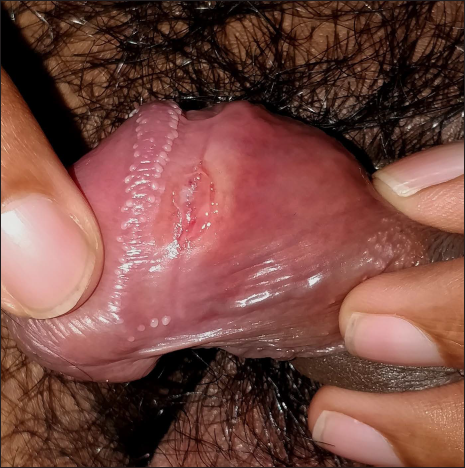Translate this page into:
Masson-Fontana stain: A silver lining for diagnosis of primary syphilitic chancre
Corresponding Author: Dr. Gopikrishnan Anjaneyan, Department of Dermatology, Amrita Institute of Medical Sciences, Amrita Vishwa Vidyapeetham, Ponekkara, Kochi, Kerala, India. drgopikrishnana@gmail.com
-
Received: ,
Accepted: ,
How to cite this article: Anjaneyan G, Kumar A, Thomas J. Masson-Fontana stain: A silver lining for diagnosis of primary syphilitic chancre. Indian J Dermatol Venereol Leprol 2022;88:822-4.
Sir,
Syphilis is a sexually transmitted infection caused by the spirochaete, Treponema pallidum subsp. Pallidum. Its first stage, primary syphilis, is a local infection due to spirochaete replication at the site of inoculation, after contact with an infected person.
Treponema pallidum is a motile, slow-growing fastidious bacterium of the order Spirochaetales and humans are their only natural host. It is a slender spiral bacterium measuring around 10–15 microns in length and 0.10–0.15 microns in width, and thus, difficult to visualize on direct microscopy.1 We successfully demonstrated spirochaetes by light microscopic examination from Masson-Fontana silver-stained smear from a suspected syphilitic chancre.
A 30-year-old unmarried male presented with a single painless penile ulcer of one-week duration. He reported sexual contact with three different partners, with the last unprotected exposure occurring two months back. Examination revealed a single indurated ulcer sized 2×1 cm at the coronal sulcus [Figure 1] with two discrete non-tender right inguinal lymph nodes. There were no systemic complaints and examination of other sites including oral and perianal areas were unremarkable. Serological tests for other sexually transmitted infections including HIV, hepatitis B and C were negative.

- Single hard chancre at the coronal sulcus
Rapid plasma reagin was reactive only in undiluted serum and not in serial dilutions. To exclude false positivity, we sent the serum for Treponema pallidum haemagglutination test along with a smear from ulcer base for Masson-Fontana silver staining. The Masson-Fontana silver stained smear demonstrated multiple spiral slender spirochaetes confirming the diagnosis of primary syphilis [Figure 2]. Treponema pallidum haemagglutination test was also reactive in 1:80 titre; the very low titers of both rapid plasma reagin and Treponema pallidum haemagglutination test possibly indicated the early phase of primary syphilis.

- Smear from ulcer base showing multiple slender spiral spirochaete (in blue circles) (Masson-Fontana silver stain 1000× magnification)
Injection benzathine penicillin 2.4 million units intramuscular (IM) was administered (1.2 million units in each buttock) after a negative penicillin skin sensitivity test. The genital ulcer healed within one month and rapid plasma reagin repeated after three months and became non-reactive.
The mainstay of syphilis diagnosis includes a demonstration of spirochaetes by dark-ground illumination or direct fluorescent antibody microscopy from ulcer exudates or mucocutaneous lesions, or serologic testing for surrogate markers of Treponema pallidum infection.2,3
Direct detection methods are particularly valuable in primary syphilitic chancres, as serological tests may be non-reactive. Among the various direct detection methods, only dark-ground illumination and polymerase chain reaction meet Centers for Disease Control and Prevention (CDC) criteria for laboratory confirmation of syphilis.4
Direct fluorescent antibody is not routinely performed in clinical settings because of high cost and the requirement of expert manpower to accurately interpret the results.
Availability, expertise and operational difficulties associated with dark-ground illumination make it a very subjective test with low sensitivity.
Direct fluorescent antibody, Treponema pallidum specific immunohistochemistry and polymerase chain reaction detection methods are not available at our centre and dark-ground illumination from wet smear failed to demonstrate spirochaetes. Thus, we decided to use Masson-Fontana silver stain for directly staining the spirochaete, to reduce subjective error.
An impression smear was made from the chancre using a sterile glass slide and air-dried. In the laboratory, the smear was first treated by Fontana’s fixative containing formalin and glacial acetic acid. After fixation, it was treated with Fontana’s mordant containing tannic acid to increase the affinity of the stain. Following fixation, the smear was treated with alcohol and covered with Fontana’s stain containing ammoniacal silver nitrate and heated till steam appeared. The smear was washed with water, air-dried and observed using oil immersion microscopy. The silver oxide precipitated on the organism, increasing its diameter and staining it brownish-black.
Further studies are required to ascertain the reliability and validity of this test for diagnosing primary syphilis. Masson-Fontana silver stain provides direct evidence of spirochaetes and hence can be used as a supplemental or confirmatory test for primary syphilis, especially in early cases with ambiguous serology.
Declaration of patient consent
Patient’s consent not required as patients identity is not disclosed or compromised.
Financial support and sponsorship
Nil.
Conflict of interest
There are no conflicts of interest.
References
- An update on the global epidemiology of syphilis. Curr Epidemiol Rep. 2018;5:24-38.
- [CrossRef] [PubMed] [Google Scholar]
- The immunopathobiology of syphilis: The manifestations and course of syphilis are determined by the level of delayed-type hypersensitivity. Am J Dermatopathol. 2011;33:433-60.
- [CrossRef] [PubMed] [PubMed Central] [Google Scholar]
- Update on syphilis: Resurgence of an old problem. JAMA. 2003;290:1510-4.
- [CrossRef] [PubMed] [Google Scholar]
- Sexually acquired syphilis: Laboratory diagnosis, management, and prevention. J Am Acad Dermatol. 2020;82:17-28.
- [CrossRef] [PubMed] [Google Scholar]





